We have shoes with heels high as standing cats, fine sandals, and boots growing higher and higher. As seen on yesterday’s movie stars, high heels and gorgeous shoes last for some generations now. But what did our ancestors wear to impress men?
Actually, the traditional footwear of some nations is based on some natural science knowledge. Furthermore, despite the fact that the majority of them are as down-to-earth as they could be, you could find some geographical and historical elements within them.
There’s another very interesting aspect that can be seen when studying shoes (I feel like Polly McShane dealing with Lithuania and its spoons). If you take a look at each pair of shoes, they would seem very distinct and a difficult fit in the end. But if you take an overall look at all of the footwear, you’ll notice that they’re very similar to those of neighboring nations, other countries of the same continent, or you could recognize some similarities in nations from other continents.
Moreover, did you know that some century-old footwear was adapted and are underlying the ordinary summer flip-flops?
On this page:
Geta – the Japanese high heel
Particular Japanese footwear, geta strongly resemble those summer flip-flops that are anchored between the first two toes. But, unlike them, the soles are wooden, and commonly rest upon two “teeth” placed perpendicular on the walk direction.
Apparently they’re impossible to wear, but a walk in these shoes strongly resembles wearing platforms.
If the two “teeth” version is understandable, the one with a single “tooth” – called tengu geta – will seem to be from a circus act. Unexpectedly, tengu geta are fairly easy to wear:
Who, and in what circumstances, would wear such things? Basically, everyone – men and women alike. They can be worn in any type of weather, by anyone with a practical mind. They’re good to wear during the summer instead of sandals. They’re good during the rainy seasons, as they raise the feet; they’re stable and don’t let moisture reach your feet, unless you are crossing a river. They’re also great to wear with very long dresses, as they’re good at detouring the mud. There is also a winter version with spiked soles.

Do you have any idea how long their history is?! Their ancestors, tageta, date as far back as Jesus. They were created for those who worked on the rice plantations. They were on a roll in the Yayoi period (300 B.C.- 300 A.D.) 1)”Introduction to Japanese Culture” by Daniel Sosnoski, published by Tuttle Publishing in 1996.
Tired of his feet getting wet through his woven sandals, an innovative Japanese thought about raising the tageta. The height grew, but the name was shortened to: geta.
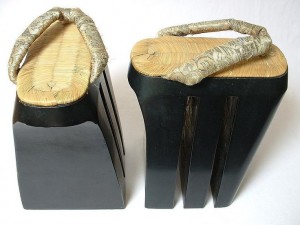
Never mess with women’s ability to make the most uncomfortable shoes. As they were also doing their jobs, the courtesans (called oiran) from the Genroku period (1688-1704) managed to transform geta, shoes that are as practical as they come, into yujo geta, with a height of approximately 30 centimeters (so that everyone could know who ranked higher amongst pleasure-dealing women). These shoes are also called koma geta, but not because by walking in them you risk falling into a coma. Although the risk of falling is very real. The courtesans were wearing heavy kimonos and gigantic wigs, thus, walking safely on something that high, they would have needed two aids 2)”Introduction to Japanese Culture” by Daniel Sosnoski, published by Tuttle Publishing in 1996.
Here you have a walk demonstration, specific for oiran, but on koma geta of just 15 centimeters:
Would you ever think there’s anything sexy about koma geta?!
Shortly after the trend changed for the courtesans, it caught on to prostitutes at parades. Why is that – you would ask astonished? Walking on geta creates some specific noises, noises that attract more attention than the silent walking. Then again, it was a great excuse for walking slowly and to be admired as thorough as possible.
Fortunately, the shoe models were improved so that they were easier to wear. The three “teeth” that were basic features on koma geta, provide good stability, even at greater heights of these platforms.
Are you interested in a pair of geta? Then get yourself a piece of wood, a device that can punch holes in it and some cloth. The piece of wood has to be made out of a flat surface for the sole and 1-3 “teeth” underneath it. On the opposite side of the “teeth” place the cloth in a V shape. The three endings of the V shape will have to be placed through the piece of wood (in which a hole has already been cut) and you fix them firmly. Now make a recording of you wearing it and you’ll become an antidepressant.
Okobo – sandals of geishas in the making
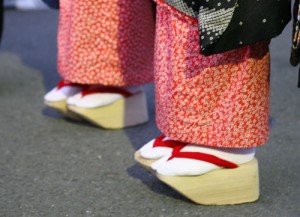
Let’s venture a little bit more into Japan. This time we’ll take a look at the feet of the geishas in the making, called maiko.
The sandals made out of willow wood, and worn mostly by young Japanese women with artistic aspirations, are called okobo. They are tied around the foot with some colored ribbons. Now don’t think that each of them get to chose their colors. On the contrary, the rules state that red is for rookies and yellow is for those that are just about to become geishas 3)”Geisha – The Mysterious Japanese Entertainer” by Joachim Schliesinger, published by Booksmango in 2015.
Given their height, can you guess why they were worn? Exactly, to prevent the kimonos from getting filthy.
Okobo resembles geta a bit, but minus the “teeth”, and the tip is blunt.
Are you thinking of getting a pair for yourself for a carnival or for any of your fantasies? They’re still making those. They can be bought off the Internet at a relatively reasonable price.
Kabkabs – for wealthy women

What type of interesting shoes did women wear in the Middle East? In Lebanon, Syria, Egypt, and other Arab countries, they had kabkabs (the name comes from the sound that they make when worn). They’re wooden shoes, which have a couple of boards underneath them, up to 14 centimeters in height.
Judging by their description, they seem to have a simple aspect, but, normally, they have lots of ornaments, the majority of which are made out of pearl-encrusted silver tassels.
They were invented out of practicality reasons, to keep the fairest princesses from touching the bathroom floors. As the height compelled them to take small and slow steps, these shoes became representative for women with too much time on their hands. As time passed, they became emblematic for wealthy women and were worn all around the house 4)”Arabic Proverbs: The Manners and Customs of the Modern Egyptians” by J.L. Burckhardt, published by Routledge in 2005.
The more sophisticated models were also used in special situations, like weddings 5)”Camel’s Tales: The Journey to Bethlehem” by Rosemarie Casello-Atassi, published by Xlibris Corporation în 2013. It must have been some sort of test: by proving that they could walk on something like that, they also proved that they were in great shape.
I really like the kabkabs and I would have the courage to try parading around at a party. They would be some authentic women shoes. Where can you buy them and how much do they cost? I’ve found a pair on E-bay at the price of $100 and there are several ads on websites with the same profile.
Have you noticed any similarity between kabkabs and geta? Both have similiar boards placed across the walking direction. The difference is the way they’re strapped to the foot and how willing each nation was to decorate it.
I have to remind you that in the period of their appearance, many centuries ago, Arabs were less likely to visit Japan or the other way around. (Between you and me, they’re not very keen on interacting that much nowadays either). Doesn’t it seem interesting how two completely different nations had similar ideas for protecting their feet?
Paduka – the simplest slippers
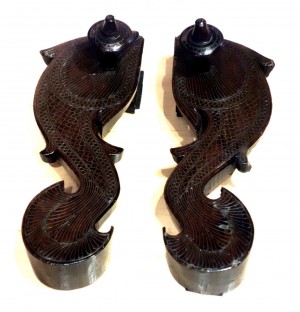
Let’s visit some more of Asia. How does India sound to you? Citizens there have some splendid padukas.
How do you not know what paduka are? It’s a type of archaic footwear worn by Indians and other neighboring nations. It’s also known as khadau. They’re entirely made of wood, consisting of a plate and some sort of nob which sits between the first two toes.
Seems uncomfortable? You’re right, maybe that’s why they were mostly worn by women.
We’re talking about India here. Can you guess what kind of wood they were made of? In the beginning, there was a legend which stated that the earth absorbed the electric current flow because of its gravitation. That doesn’t sound good to me and neither did it sound good to the Indians then. Thus, they resorted to using an insulator. Wood was known for its good insulation properties. It was, most probably, the only insulating material known to them, so they made paduka out of it.
At first, they were used only by priests and saints while the peasants wore cloth and leather on their feet. Sounds familiar? Leather wasn’t that trendy then, out of religious reasons, and the cloth wasn’t really that resistant. In these conditions, it didn’t take long for the paduka to be on everyone’s feet. They were kind of like the sneakers of our times, in terms of popularity.
That doesn’t necessarily mean that everyone had the exact same models. For example, we have the paduka, which were owned by The Great and Holy Sikh Kabir. Do you think they were rudimentary, made only out of wood? Not even close! They were made of silver, well garnished, and historians struggle to decipher the engraved inscriptions that were found on them.
While paduka for women started having a more refined aspect, they were raised more and more and gained all sorts of decorations. Even brides wear them.
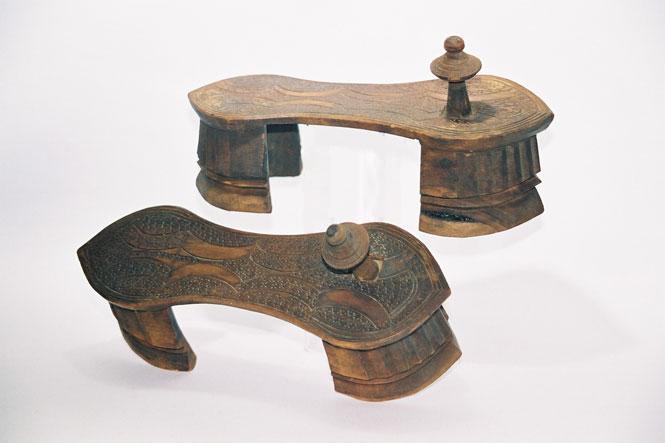
Anyhow, it’s essential to own a pair of padukas if you plan on visiting a Hindu temple. Therefore, you must enter barefooted as no other type of footwear is allowed there. As a matter of fact, you are not even allowed to enter with paduka if you wore them outside. Think of them as slippers.
In general, these are useful in India, as the air is very warm and moist, ideal for making you feel like walking into hell. The paduka will be there for your rescue, as the wood cools you off and absorbs the moisture.
You can buy these in India from souvenir shops. Or online, but they will be sent from India.
Lotus shoes – for tiny feet

Do you have the audacity of thinking that you have the smallest feet in history? You couldn’t be more wrong.
For some centuries, the Chinese used to wrap the feet of small girls very tightly so that they wouldn’t grow. Being smaller than the normal foot, there were these special shoes called the lotus shoes.
Foot wrapping probably appeared around the 10th century, and was used amongst the dancers of the Palace to enhance their grace. Then it became a habit, specific for the high society, so the aspect of the shoes had to be accordingly. The interior was padded with cotton or silk and was decorated in many different ways.
At one point, the tiny feet of women were so appreciated that the custom caught onto the middle class and even lower 6)”Every Step a Lotus: Shoes for Bound Feet” by Dorothy Ko, published by University of California Press în 2001. Cinderella would have had great rivalry.
This went one until the Chinese dropped this cruelty. Nowadays, there are only a handful of old women who could wear lotus shoes. Otherwise, there is no one who could fit them; thus, they can only be admired in museums and cannot be bought as a souvenir from anywhere.
Chopine – the Mediterranean shoes

In the southern part of Europe, especially Italy and Spain, from the nothingness of history, shoes called chopine appear. They’re a type of sandal perched on some rocks – which, unfortunately, got stuck to them.
Do you have any idea why they were so heightened? Two reasons: to keep mud from the pathway away from the wearers dresses and so that they could show off their rank in society. The higher the chopine, the higher they ranked in society.
It was enough for some courtesans to wear them a couple of times and they became popular. Moreover, there was a contest amongst women during the Renaissance period, on “who has the tallest chopines“, especially in Venice. (How were you supposed to hop on a gondola wearing such things?!) The height of these shoes got so big that even William Shakespeare joked about their stance.
Did you think that the koma getas were high? Chopine reached 75 centimeters 7)”Stiltwalking: A History and How To” by Roy Malo, published by Lulu in 2013! Some sort of stilts on which you would always be “up to the mark”.
Such high footwear must have been made out of some resistant materials, right? Actually, they were made from cork and some wood, as it was very important that the shoes were light. In Spain, some metal was added, but there wasn’t that much thought put into designing them.
French bride shoes – dynamic as the groom
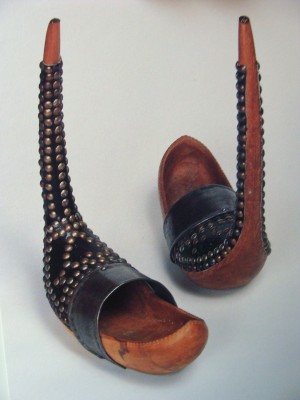
At any wedding, the bride has the most graceful shoes. Only shoes for those deceased could be less resistant. How would a wedding where the floor would roar (or eventually break completely?) be, as the bride would be wearing some solid shoes made out of solid wood? I don’t know how the floors were at about 1800, but wooden shoes for brides definitely existed in France.
They made their appearance in the 19th century in a town in Bethmale Valley. Legend has it that during the Moorish invasion in the 12th century, the fiancé of a local, that was part of the resistance, would have been seduced by an enemy. Shortly after the Moors were defeated, the cheated one roamed in front of all women in the area with the hearts of the two lovers pinned on top of the shoes. This parade was done so that everyone would know that no one escapes punishment when cheating on a mountaineer man 8)”The Art of the Shoe” by Marie-Josèphe Bossan, published by Parkstone Press in 2004.
After some time, these shoes became wedding shoes. The groom gave them to the bride as a gift, so that everyone remembered where the place of the potential lover’s heart is.
The length of the front part was considered proportional with the love of the groom for his wife. Now nobody can say that size doesn’t matter in love!
The shoes were made out of walnut wood and the branches of the tree were directed to grow in the shape of the shoe. The groom was supposed to craft them in a pointy shape.
I stand and wonder, was there ever a groom so in love that he made the front part of the shoe so long that it would rise past the bride’s nose?
Anyway, as long as the woman used them, the man was supposed to keep his mouth shut. Otherwise, who knows what else could have been pinned onto the sharp end of the shoe. Mountaineer women aren’t that subtle either!
Piece together all information that you have received regarding the traditional footwear. Compare the images between them. Do you see any similarities? Differences? What conclusions can you draw? Try guessing their history, how they were used, how they were seen in society with the passing of time, how would you be able to walk in them?
Many stories are lying behind them. And even if the majority of them have been lost with the passing of time, you can always make up new ones. They’re all fantastic!
A review of the past centuries' most spectacular footwear for men, as well as numerous surprising facts about their history
References
| ↑1, ↑2 | ”Introduction to Japanese Culture” by Daniel Sosnoski, published by Tuttle Publishing in 1996 |
|---|---|
| ↑3 | ”Geisha – The Mysterious Japanese Entertainer” by Joachim Schliesinger, published by Booksmango in 2015 |
| ↑4 | ”Arabic Proverbs: The Manners and Customs of the Modern Egyptians” by J.L. Burckhardt, published by Routledge in 2005 |
| ↑5 | ”Camel’s Tales: The Journey to Bethlehem” by Rosemarie Casello-Atassi, published by Xlibris Corporation în 2013 |
| ↑6 | ”Every Step a Lotus: Shoes for Bound Feet” by Dorothy Ko, published by University of California Press în 2001 |
| ↑7 | ”Stiltwalking: A History and How To” by Roy Malo, published by Lulu in 2013 |
| ↑8 | ”The Art of the Shoe” by Marie-Josèphe Bossan, published by Parkstone Press in 2004 |
Did you like it? Now it’s your turn. You’ll make us very happy if you share this article with your friends:
And don’t forget to let us know what you think – we are really interested in your thoughts on this!

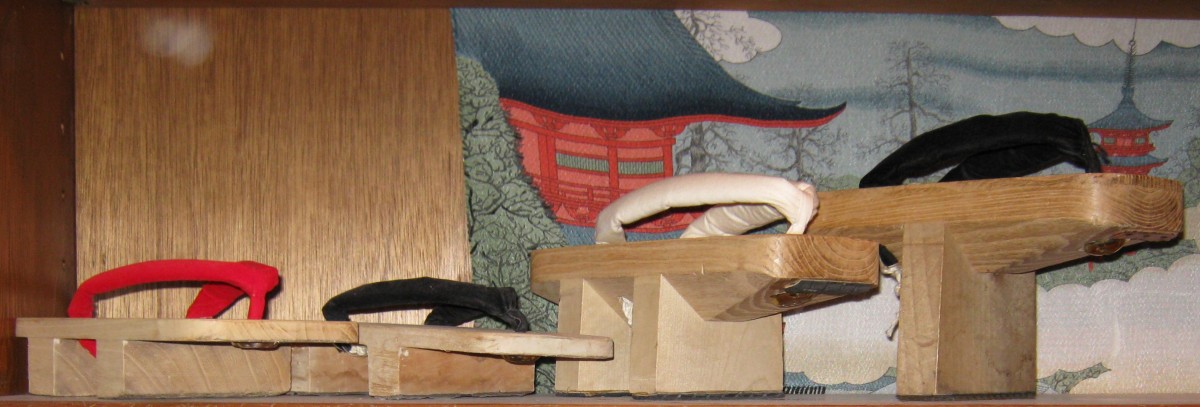


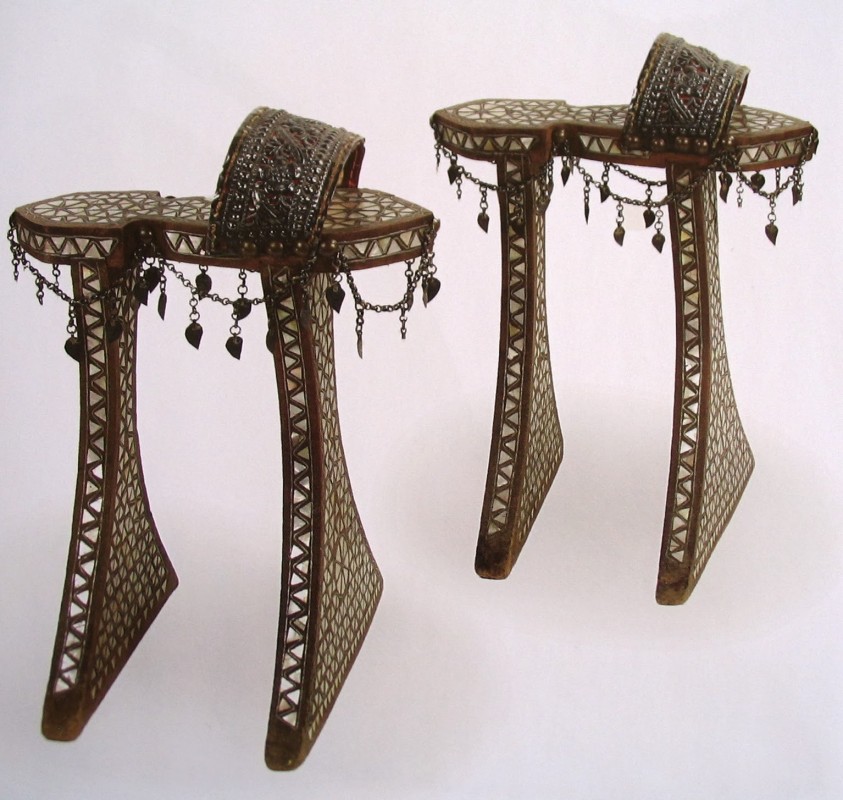
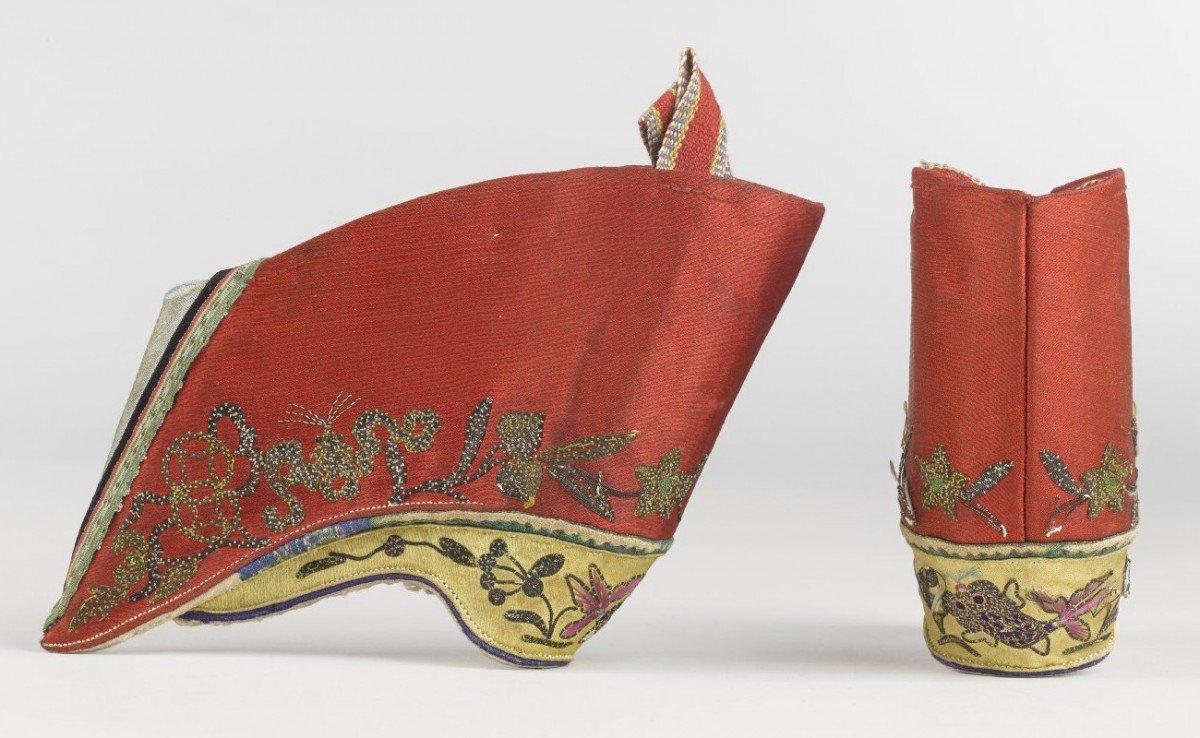
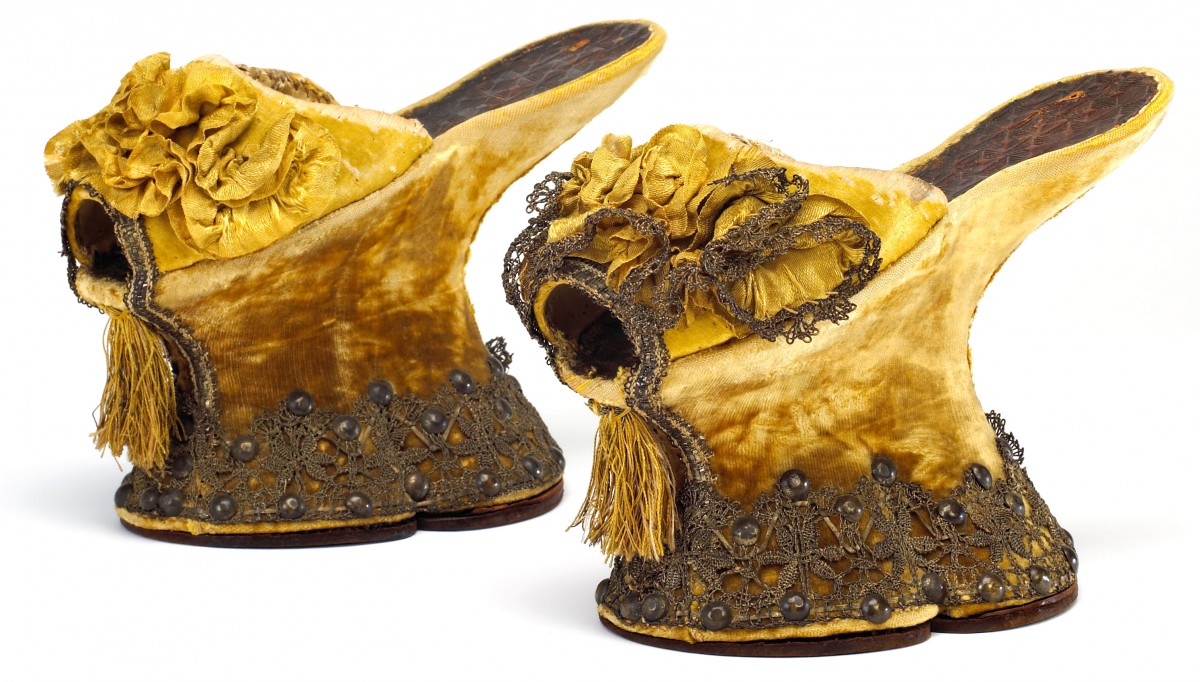
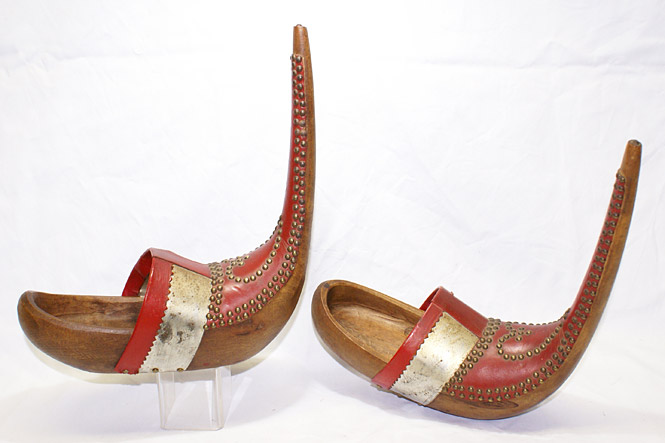


Another old(historic?) shoes are the wooden clogs from Sweden and the Netherlands. They have gone over various iterations to become one of the popular fashion styles in today’s time but also have a rich history of style and comfort. Thank you for the post.
Really a great and helpful article. I clearly understand what the author dictated and really mean it what earliar people like in shoes.